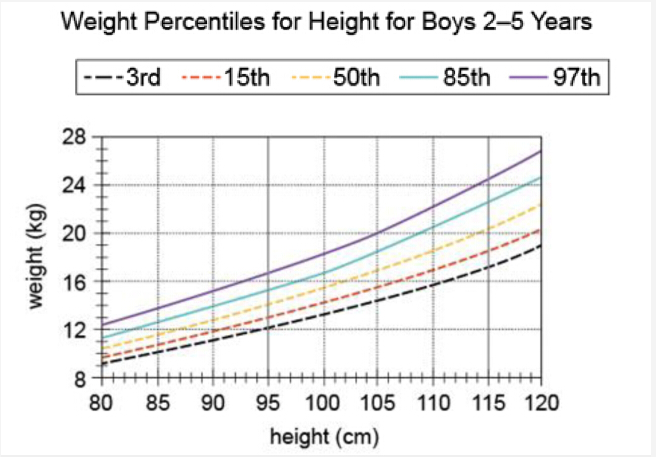题目信息
 Height-for-age standards
Height-for-age standardsThe World Health Organization (WHO) has produced a comprehensive set of growth standards for children. These standards are based on studies of children living in 6 nations on 5 continents under optimal conditions with respect to health and nutrition. The table displays the percentile distribution of height, in centimeters, at 3-month intervals, for boys ages 2 through 5 according to the WHO model In a model population-a large population of boys ages 2 through 5 that conforms to the WHO growth standards-for n = 3,15,50,85, and 97, the nth percentile in height for a given age is the unique height among boys of that age that is greater than or equal to n percent, and less than or equal to (100- n) percent, of heights of boys of that age.
Weight-for-height standards
The graph shows the percentile distribution of weight, in kilograms, for heights from 80 cm to 120 cm, for boys ages 2 through 5, according to the WHO model. In a model population, for n = 3,15,50,85, and 97, the nth percentile in weight for a giver height is the unique weight among boys of that height that is greater than or equal to n percent, and less than or equal to (100-n) percent, of weights of boys of that age.

Consider an individual boy from a model population. Suppose that from age 2 through age 5, this boy's weight is at the 97th percentile for his height and his height is at the 97th percentile for his age. Which one of the following statements must be true of the boy at age 5 years 0 months?
A:His age is at the 97th percentile for his height.
B:His weight is at the 97th percentile for his age.
C:His height is at the 97th percentile for his weight.
D:His weight is approximately 166% of his weight at age 2 years 0 months.
E:His weight is approximately 197% of his weight at age 2 years 0 months.
参考答案及共享解析

共享解析来源为网络权威资源、GMAT高分考生等; 如有疑问,欢迎在评论区提问与讨论
本题耗时:
已选答案:
正确答案:
D:His weight is approximately 166% of his weight at age 2 years 0 months.
权威答案解析正在整理中,即将上线。
 加入收藏
加入收藏
 在线答疑
在线答疑
题目来源



























